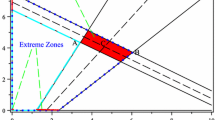Abstract
The famous Allen's interval relations constraint propagation algorithm was intended for linear time. Its 13 primitive relations define all the possible mutual locations of two intervals on the time-axis. In this paper an application of the algorithm for non-linear time is suggested. First, a new primitive relation is added. It is called excludes since an occurrence of one event in a certain course of events excludes an occurrence of the other event in this course. Next, new composition rules for relations between intervals are presented: some of the “old” rules are extended by the relation excludes, and entirely new ones are formulated for composing the relation excludes with the other relations. Four different composition tables are considered. The choice of a composition table depends on whether time is branching or not, and whether intervals can contain non-collinear subintervals or not.
Similar content being viewed by others
References
Allen, J.F., 1983, “Maintaining Knowledge about Temporal Intervals,” Communications of ACM 26(11), 832–843.
Allen, J.F. and Koomen, J., 1983, “Planning Using a Temporal World Model”, pp. 741–746 in Proceedings of the Eighth International Joint Conference on Artificial Intelligence, Karlsruhe, Germany, Morgan Kaufmann Publishers.
van Beek, P., 1989, “Approximation Algorithms for Temporal Reasoning”, pp. 1291–1296 in Proceedings of the Eleventh International Joint Conference on Artificial Intelligence, Detroit, USA, Morgan Kaufmann Publishers.
Dechter, R., Meiri, I., and Pearl, J., 1991, “Temporal Constraint Networks,” Artificial Intelligence 49, 61–95.
Hajnicz, E., 1991, Representation and Formal Description of Non-linear Time Structures for Artificial Intelligence, Ph.D. Thesis, Institute of Computer Science, Polish Academy of Sciences, Warszawa (in Polish).
Hajnicz, E., 1996, “Some considerations on non-linear time intervals”, Journal of Logic, Language and Information 4, 335–357.
Hogge, J.C., 1988, “Prevention Techniques for a Temporal Planner”, pp. 43–48 in Proceedings of Seventh AAAI Conference, Saint Paul, Minnesota, Morgan Kaufmann Publishers.
Hrycej, T., 1986, A Trasitivity-Based Algorithm for Temporal Constraint Propagation, Technical Report TEX-B Memo 13-86, Munich.
Kautz, H.A., 1987, A Formal Theory of Plan Recognition, Ph.D. Thesis, Department of Computer Science, University of Rochester, Rochester.
Keretho, S. and Loganantharaj, R., 1993, “Reasoning about Networks of Temporal Relations and Its Applications to Problem Solving,” Applied Intelligence 3(1), 47–70.
Koomen, J.A.G.M., 1989, “Localizing Temporal Constraint Propagation”, pp. 198–202 in Proceedings of the First International Conference on Principles of Knowledge Representation and Reasoning, Toronto, Canada, Morgan Kaufmann Publishers.
Koubarakis, M., 1992, “Dense Time and Temporal Constraints with ≠,” pp. 24–35 in Proceedings of the Third International Conference on Principles of Knowledge Representation and Reasoning, Cambridge, MA, Morgan Kaufmann Publishers.
Man-Kam Yip, K., 1985, “Tense, Aspect and the Cognitive Representation of Time”, pp. 807–814 in Proceedings of the Ninth International Joint Conference on Artificial Intelligence, Los Angeles, Morgan Kaufmann Publishers.
Poesio, M. and Brachman, R.J., 1991, “Metric Constraints for Maintaining Appointments: Dates and Repeated Actions,” pp. 241–246 in Proceedings of the ninth AAAI Conference, Anaheim, CA, MIT Press.
Rodriguez, R.V., 1993, “A Relativistic Temporal Agebra for Efficient Design of Distributed Systems”, Applied Intelligence: The International Journal of Artificial Intelligence, Neural Networks and Complex Problem-Solving Technologies 3, 31–45.
Tsang, E.P.K., 1986, The Interval Structure of Allen's Logic, Technical Report CSCM-24, University of Essex, Colchester.
Vilain, M. B. and Kautz, H., 1986, “Constraint Propagation Algorithms for Temporal Reasoning”, pp. 377–392 in Proceedings of Fifth AAAI Conference, Philadelphia, Morgan Kaufmann Publishers.
Author information
Authors and Affiliations
Rights and permissions
About this article
Cite this article
Hajnicz, E. Applying Allen's constraint propagation algorithm for non-linear time. J Logic Lang Inf 5, 157–175 (1996). https://doi.org/10.1007/BF00173698
Received:
Accepted:
Issue Date:
DOI: https://doi.org/10.1007/BF00173698




